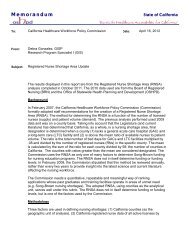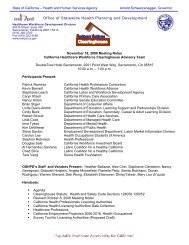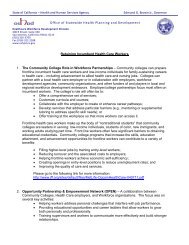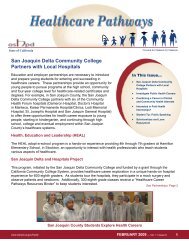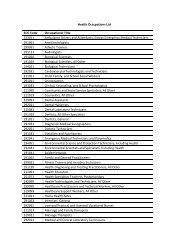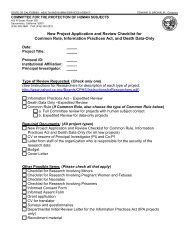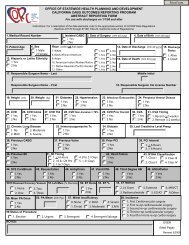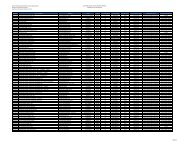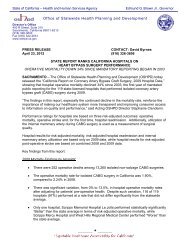Best Practices for Project Management, Design, and Construction of ...
Best Practices for Project Management, Design, and Construction of ...
Best Practices for Project Management, Design, and Construction of ...
You also want an ePaper? Increase the reach of your titles
YUMPU automatically turns print PDFs into web optimized ePapers that Google loves.
• Cali<strong>for</strong>nia Air Quality <strong>Management</strong> Districts <strong>for</strong> <strong>Construction</strong> <strong>and</strong> Emergency Generator<br />
Operations<br />
The Cali<strong>for</strong>nia Environmental Quality Act<br />
The local jurisdiction is typically the lead agency in the Cali<strong>for</strong>nia Environmental Quality Act<br />
(CEQA) process. The Registered <strong>Design</strong> Pr<strong>of</strong>essional is responsible <strong>for</strong> ensuring that the project<br />
con<strong>for</strong>ms to the requirements <strong>of</strong> CEQA. Minor renovations normally do not trigger CEQA<br />
compliance, but a major addition or remodel might. New buildings will require CEQA compliance,<br />
even if it is declared not to have an impact to the environment (a Negative Declaration). Specific<br />
requirements <strong>and</strong> regulations <strong>for</strong> CEQA can be found at http://ceres.ca.gov .<br />
The local jurisdiction is typically the lead agency in the CEQA process. OSHPD relies on the<br />
Registered <strong>Design</strong> Pr<strong>of</strong>essional to coordinate the local requirements with the project, in particular,<br />
any zoning <strong>and</strong>/or unique building code requirements imposed by a local jurisdiction need to be<br />
coordinated with the local agency. With a new building project especially, the site work will fall<br />
under the jurisdiction <strong>of</strong> the local agency. However, OSHPD will claim jurisdiction over the site fire<br />
water line as well as other jointly reviewed features <strong>and</strong> will ensure that there is a code-compliant<br />
path <strong>of</strong> travel to the public way at the property line <strong>and</strong> compliance with accessible parking<br />
requirements.<br />
3.2 General <strong>Best</strong> <strong>Practices</strong> <strong>for</strong> the <strong>Project</strong> Drawings<br />
Quality in Documentation<br />
Many architectural firms have documentation st<strong>and</strong>ards that are the mainstay <strong>of</strong> their practice,<br />
developed over many years <strong>of</strong> successful projects <strong>and</strong> improved upon as codes <strong>and</strong> technology<br />
have evolved. The guidelines <strong>of</strong>fered in this section are not meant to suggest a better way <strong>of</strong><br />
per<strong>for</strong>ming architectural documentation, but merely <strong>of</strong>fer suggestions to individuals <strong>and</strong> firms that<br />
do not have the benefit <strong>of</strong> developing st<strong>and</strong>ards that many larger firms must do to ensure quality<br />
documents.<br />
The “customers” <strong>for</strong> the architectural documents are large <strong>and</strong> varied—clients, engineers <strong>and</strong><br />
consultants, contractors <strong>and</strong> vendors, as well as building <strong>of</strong>ficials. Although some are<br />
knowledgeable on how to read <strong>and</strong> use construction documents, there are still those who will be<br />
unfamiliar with specific graphic conventions, or common ways that are unique to an individual<br />
practice. The best practice is to be sure the documents are as user friendly as possible.<br />
For every project, the goal is to prepare a set <strong>of</strong> documents that appears to have been prepared<br />
by a single entity. It is important that all disciplines (<strong>and</strong> outside consultants) adhere to the same<br />
set <strong>of</strong> basic graphic st<strong>and</strong>ards that guide the preparation <strong>of</strong> the architectural documents.<br />
Organizations like the AIA, CSI <strong>and</strong> National Institute <strong>of</strong> Building Sciences work jointly to create<br />
national st<strong>and</strong>ards <strong>for</strong> consistent documentation <strong>and</strong> data organization, to assist in<br />
communication <strong>and</strong> coordination across the design <strong>and</strong> construction industry. (See<br />
http://www.nationalcadst<strong>and</strong>ard.org <strong>for</strong> more in<strong>for</strong>mation.)<br />
(OSHPD <strong>Best</strong> <strong>Practices</strong>) Page 12 DRAFT FINAL, Sept. 2011



